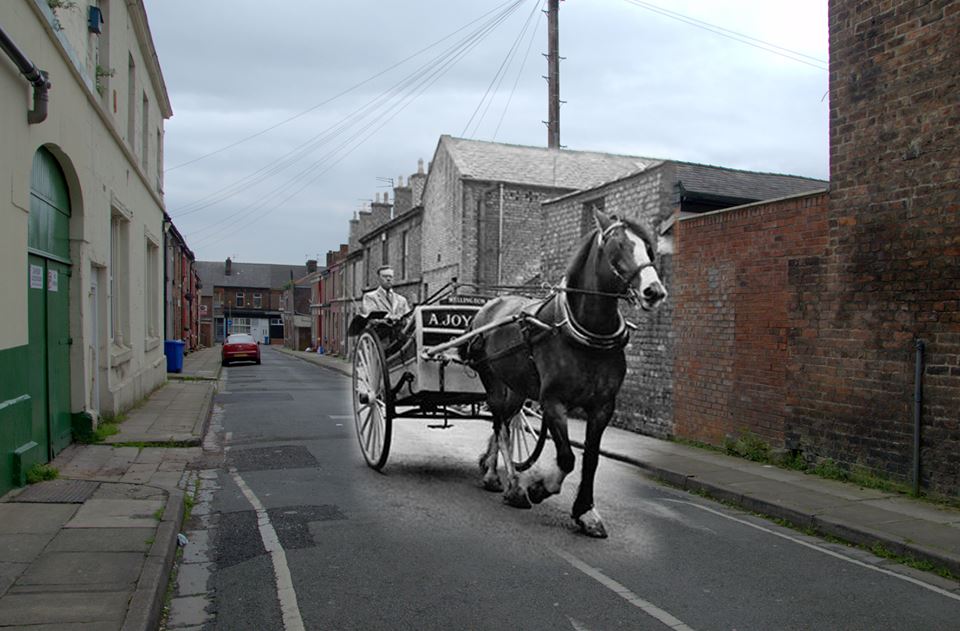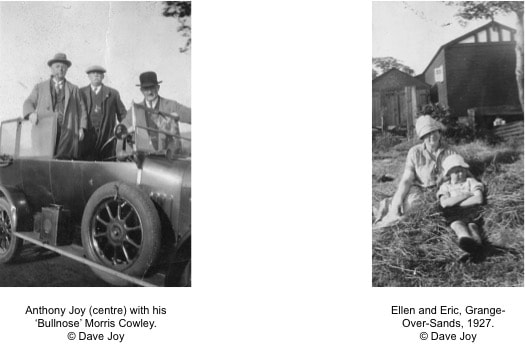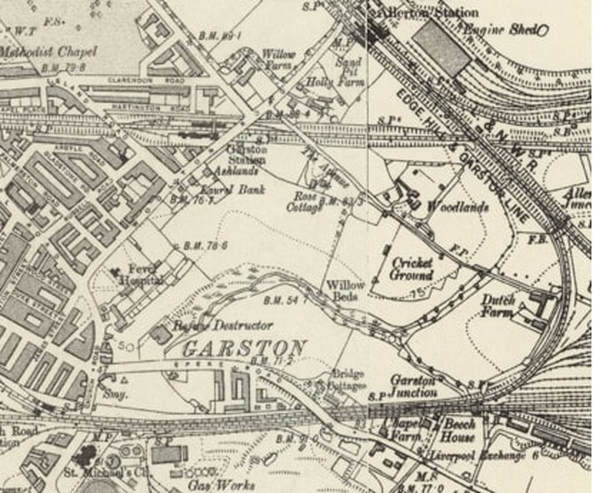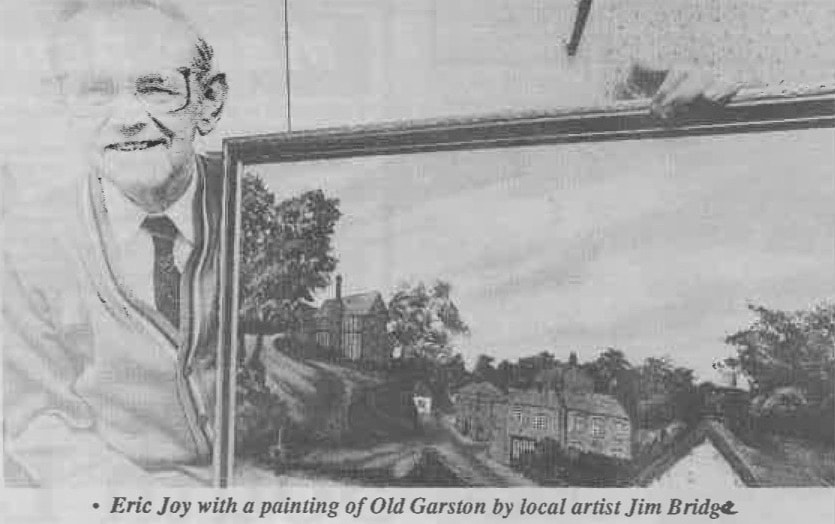“I wish I’d asked more questions when I was younger.” How often do we hear that phrase uttered in frustration when talking about family history? That realisation that so much information about a way of life that was unknown to us (or was, at best, a childhood memory), was vivid in the minds of people who were known to us, people with whom our lives overlapped for, perhaps, too short a time.
It was a similar realisation that first prompted me to commit pen to paper and write my own memoir – that, if I didn’t take steps to record it, then once I was gone, that memory would be gone also. Yet, that very process of recording my own childhood memories of spending time with my father at Wellington Dairy, only served to compound my regret at not having asked more questions of him when I’d had the chance.
Eric Joy never needed much encouragement to talk about his past and he had an incredible memory for dates and events. Fortunately for the Joy family, both now and in the future, my younger brother had the foresight to sit Dad in front of a cassette recorder and press PLAY/REC to capture some of this priceless oral history.
The recording took place in 2002, five years before Dad passed away, and covers the years from 1919 (when Dad was born) up until 1934 (when he left school). It fills both sides of a C90 cassette (remember those?). My brother’s intention was to repeat the process until he had captured a full commentary of Dad’s life. Sadly, they never found the time or opportunity to do so. Nevertheless, what the family do have is a much-treasured record of Dad talking about his early years, which also provides a glimpse into what life was like in Garston, Liverpool, in the early twentieth century.
At the end of the memoir I’ve included two additional items: a poem written by the headmaster at Dad's school and the text from a newspaper article, published in 1991, when Dad was interviewed about ‘Garston Farm Days’.
“I wish I’d asked more questions when I was younger.” How often do we hear that phrase uttered in frustration when talking about family history? That realisation that so much information about a way of life that was unknown to us (or was, at best, a childhood memory), was vivid in the minds of people who were known to us, people with whom our lives overlapped for, perhaps, too short a time.
It was a similar realisation that first prompted me to commit pen to paper and write my own memoir – that, if I didn’t take steps to record it, then once I was gone, that memory would be gone also. Yet, that very process of recording my own childhood memories of spending time with my father at Wellington Dairy, only served to compound my regret at not having asked more questions of him when I’d had the chance.
Eric Joy never needed much encouragement to talk about his past and he had an incredible memory for dates and events. Fortunately for the Joy family, both now and in the future, my younger brother had the foresight to sit Dad in front of a cassette recorder and press PLAY/REC to capture some of this priceless oral history.
The recording took place in 2002, five years before Dad passed away, and covers the years from 1919 (when Dad was born) up until 1934 (when he left school). It fills both sides of a C90 cassette (remember those?). My brother’s intention was to repeat the process until he had captured a full commentary of Dad’s life. Sadly, they never found the time or opportunity to do so. Nevertheless, what the family do have is a much-treasured record of Dad talking about his early years, which also provides a glimpse into what life was like in Garston, Liverpool, in the early twentieth century.
At the end of the memoir I’ve included two additional items: a poem written by the headmaster at Dad's school and the text from a newspaper article, published in 1991, when Dad was interviewed about ‘Garston Farm Days’.
anthony Eric Joy - Memoir
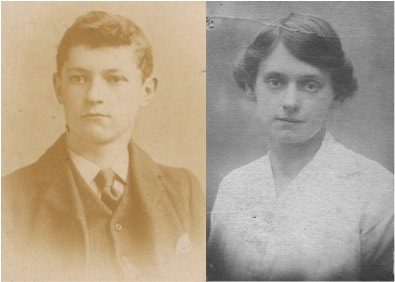 Percy & Ellen © Dave Joy 2017
Percy & Ellen © Dave Joy 2017
“I was born at 5.00 on 18th December 1919 at 39 Wellington Street. My father was Anthony Percival Joy, born 26th June 1889. My mother was Ellen Joy (nee Savage), born 21st January 1887. They were known as ‘Percy’ and ‘Ellen’.
My grandfather was Anthony Joy. He was born at Bolton Abbey in Yorkshire on 2nd August 1863 and died on 22nd February 1937 at 37 Wellington Street – the 'Dairy House', as we called it. He moved to Liverpool as a boy, in 1873, because his father, Daniel Joy, whose wife died in December 1872, came to Garston to take over a dairy in Railway Street, which his two brothers had opened ten years before, in 1863.
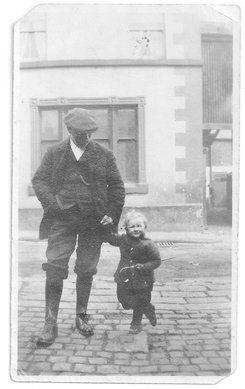 Young Eric with his 'Papa', Anthony Joy. © Dave Joy 2017
Young Eric with his 'Papa', Anthony Joy. © Dave Joy 2017
This move to the city was because life in the Dales at that time was very hard and due to the industrial revolution, the population was shifting to Liverpool and its outskirts. They came to Liverpool as dairymen - or, ‘cowkeepers’ as they became known - as they were able to sell milk, retail. And, because of the number of houses being built, their turnover was much greater than keeping a few cows and sheep up in the Dales; making a living was easier in the city.
Anthony grew up at the dairy in Railway Street. (When Garston Church was rededicated, he sang in the choir). But, he went on to have his own dairies in Garston: Island Road Dairy and Wellington Dairy (Duke Street). I called my grandfather ‘Papa’. I think it was because my dad called him ‘Pa’ and I tried to say ‘grandpa’ but it came out as ‘papa’. And then everyone started to refer to him as my ‘Papa’. Of course, I am now the ‘Papa’ of my own grandchildren!
Anthony grew up at the dairy in Railway Street. (When Garston Church was rededicated, he sang in the choir). But, he went on to have his own dairies in Garston: Island Road Dairy and Wellington Dairy (Duke Street). I called my grandfather ‘Papa’. I think it was because my dad called him ‘Pa’ and I tried to say ‘grandpa’ but it came out as ‘papa’. And then everyone started to refer to him as my ‘Papa’. Of course, I am now the ‘Papa’ of my own grandchildren!
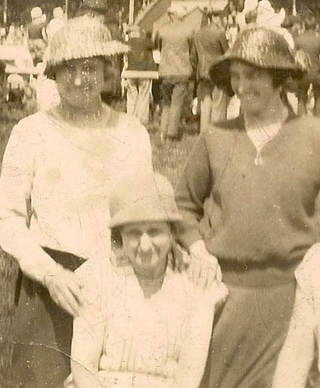 The Savage Sisters: Sarah, Ellen and Annie. © Dave Joy 2017
The Savage Sisters: Sarah, Ellen and Annie. © Dave Joy 2017
My father was born the eldest of six children on 26th June 1889. After him came a baby girl, Ellen Gertrude, born in 1891 who only lived for five months. Then, my Uncle George was born on 24th April 1893 and he was followed by my Aunty Flora, who was born on New Years Day 1897. Then, my Uncle Bill, William Cecil Joy, was born on 2nd October 1902 and my Aunty Kath (Kathleen) was born on 23rd September 1905.
My mother was the youngest of four. Her eldest brother was Samuel Savage, born in 1881 and eleven months later, her eldest sister, my Aunty Sarah, was born in 1882 on 9th May. My Aunty Annie was born in 1884 on 17th March and my mother was born in 1887 on 21st January.
Aunty Annie married Joseph Brannigan and they had a daughter, Ivy - my cousin - who was born 26th July 1914. She was born in the first house in Railway Street, opposite Garston Church. It was a very difficult birth; in fact at first they thought that she was stillborn until, as the doctors were administering to Aunty Annie, they heard a cry. During the birth she had injured her arm and she was never able to raise that arm above the level of her shoulder. She overcame this and became very good at ballroom dancing. In fact, she taught me and I was always very grateful to her for doing that.
My mother was the youngest of four. Her eldest brother was Samuel Savage, born in 1881 and eleven months later, her eldest sister, my Aunty Sarah, was born in 1882 on 9th May. My Aunty Annie was born in 1884 on 17th March and my mother was born in 1887 on 21st January.
Aunty Annie married Joseph Brannigan and they had a daughter, Ivy - my cousin - who was born 26th July 1914. She was born in the first house in Railway Street, opposite Garston Church. It was a very difficult birth; in fact at first they thought that she was stillborn until, as the doctors were administering to Aunty Annie, they heard a cry. During the birth she had injured her arm and she was never able to raise that arm above the level of her shoulder. She overcame this and became very good at ballroom dancing. In fact, she taught me and I was always very grateful to her for doing that.
1922
My earliest recollection is from about 1922. I was sitting in the milk float with my father going under Allerton Station Bridge, with a train above. The horse, Daisy, was terrified of steam trains. All I could see of her (she was a bay horse with black points) was her rump above the front of the trap, as I was so small. My dad was holding me with one hand and driving her with the other.
1923
Daisy took my nail off in 1923. I went to feed her in the big yard and I didn’t hold my hand flat enough and her teeth brushed the end of my fingers with the bread and took my nail off with it. Since then I have always held my hand flat! I was only small and I had to reach up to feed her. Next thing my Uncle George swept me up in his arms and carried me in, holding my finger up which was covered in blood. My main concern was that they wouldn’t punish the horse. Six months later I was leading her down The Avenue, going across the bridge, when a train came underneath her. She started to dance and, with me only being small, she trod on my toe and I lost my big toenail; this was all before I had started school. But none of this put me off my liking for horses!
My earliest recollection is from about 1922. I was sitting in the milk float with my father going under Allerton Station Bridge, with a train above. The horse, Daisy, was terrified of steam trains. All I could see of her (she was a bay horse with black points) was her rump above the front of the trap, as I was so small. My dad was holding me with one hand and driving her with the other.
1923
Daisy took my nail off in 1923. I went to feed her in the big yard and I didn’t hold my hand flat enough and her teeth brushed the end of my fingers with the bread and took my nail off with it. Since then I have always held my hand flat! I was only small and I had to reach up to feed her. Next thing my Uncle George swept me up in his arms and carried me in, holding my finger up which was covered in blood. My main concern was that they wouldn’t punish the horse. Six months later I was leading her down The Avenue, going across the bridge, when a train came underneath her. She started to dance and, with me only being small, she trod on my toe and I lost my big toenail; this was all before I had started school. But none of this put me off my liking for horses!
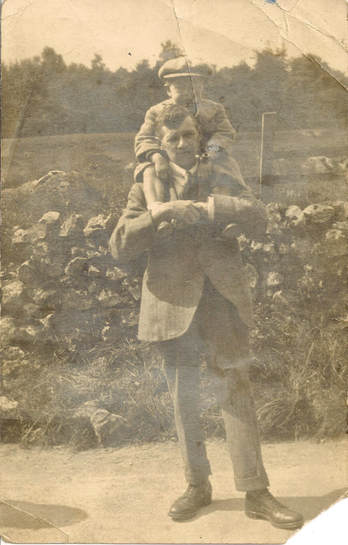 On holiday in Grassington, 1924. © Dave Joy 2017
On holiday in Grassington, 1924. © Dave Joy 2017
1924
In 1924 we had our holiday in Grassington. We went for long walks but it was all right for me because I was carried up high on my father’s shoulders. He tried to teach me how to skim stones - on the River Wharfe, near Grassington Bridge – but I was too young and just chucked them in to make a splash. I was four years old and that was the last holiday I had before starting school.
1925
I attended Island Road School in 1925, known as the Wesleyan School as it is next to the Wesleyan Chapel; the main entrance was actually located in Garston Old Road. Before I started school a friend of my Aunty Flora’s (Gerty Bramhall, later Gerty Briers), who carried me down to the church to be christened, used to take me to visit two ladies who were teachers at Island Road School, so I knew them before I started. But, it didn’t help me to like school – I hated school, I really did. I counted the days for nine years until I could leave at the age of fourteen. The reason I hated it was not because it was a bad school - I suppose I just had the wrong upbringing to enjoy school. Before school I spent all of my days with my father either going out on the milk round or working in the fields, which we cultivated for kale and oats. That is why school for me was like a prison.
There were lots of changes going on in Garston at that time. In 1925 they built Windfield Road, the estate at the top of Banks Road, and to do that they took part of Marsh’s farm. George Marsh farmed three farms all next to each other. He lived in the house at Mount Pleasant (in Bailey’s Lane at that time) and he farmed Sutton Grange, which was down Banks Lane, and also Chapel House, which was further down again. Later on, in 1932, they took all of his farms to build Liverpool Airport. Also, where there is a One-Stop-Shop now at the bottom of Speke Road, there used to be a large grocer’s shop called ‘Irwins’, built in 1925. That in turn replaced a thatched cottage called ‘Paddy Flynn’s Cottage, that had been there for donkey’s years.
1925 was also the first year that I went to Blackpool for my holidays. In those days the trams I saw running along the seafront could only be accessed from the end, not from the side; there are one or two still running today. Also, I had a ride in a landau, which was the highlight of my holidays. That year the Ferris Wheel was in Blackpool; it is no longer there, it was taken down in the early thirties. But I saw it in 1925; I didn’t go on it, as I was only 5 years old and it seemed a long way to the top. Also in Blackpool there were booths where people would come in and play a piano and ask the audience to sing a song and then try to sell the sheet music to that song. They were songs by Irvine Berlin; songs like ‘What’ll I Do’ and ‘Always’ and ‘I Remember’. Later my dad bought a gramophone record sung by Turner Layton and Claris Johnson.
In 1924 we had our holiday in Grassington. We went for long walks but it was all right for me because I was carried up high on my father’s shoulders. He tried to teach me how to skim stones - on the River Wharfe, near Grassington Bridge – but I was too young and just chucked them in to make a splash. I was four years old and that was the last holiday I had before starting school.
1925
I attended Island Road School in 1925, known as the Wesleyan School as it is next to the Wesleyan Chapel; the main entrance was actually located in Garston Old Road. Before I started school a friend of my Aunty Flora’s (Gerty Bramhall, later Gerty Briers), who carried me down to the church to be christened, used to take me to visit two ladies who were teachers at Island Road School, so I knew them before I started. But, it didn’t help me to like school – I hated school, I really did. I counted the days for nine years until I could leave at the age of fourteen. The reason I hated it was not because it was a bad school - I suppose I just had the wrong upbringing to enjoy school. Before school I spent all of my days with my father either going out on the milk round or working in the fields, which we cultivated for kale and oats. That is why school for me was like a prison.
There were lots of changes going on in Garston at that time. In 1925 they built Windfield Road, the estate at the top of Banks Road, and to do that they took part of Marsh’s farm. George Marsh farmed three farms all next to each other. He lived in the house at Mount Pleasant (in Bailey’s Lane at that time) and he farmed Sutton Grange, which was down Banks Lane, and also Chapel House, which was further down again. Later on, in 1932, they took all of his farms to build Liverpool Airport. Also, where there is a One-Stop-Shop now at the bottom of Speke Road, there used to be a large grocer’s shop called ‘Irwins’, built in 1925. That in turn replaced a thatched cottage called ‘Paddy Flynn’s Cottage, that had been there for donkey’s years.
1925 was also the first year that I went to Blackpool for my holidays. In those days the trams I saw running along the seafront could only be accessed from the end, not from the side; there are one or two still running today. Also, I had a ride in a landau, which was the highlight of my holidays. That year the Ferris Wheel was in Blackpool; it is no longer there, it was taken down in the early thirties. But I saw it in 1925; I didn’t go on it, as I was only 5 years old and it seemed a long way to the top. Also in Blackpool there were booths where people would come in and play a piano and ask the audience to sing a song and then try to sell the sheet music to that song. They were songs by Irvine Berlin; songs like ‘What’ll I Do’ and ‘Always’ and ‘I Remember’. Later my dad bought a gramophone record sung by Turner Layton and Claris Johnson.
1926
In 1926 the biggest thing for this country was the ‘Railway Strike; in fact it was a General Strike in which the army commandeered buses in the city to take people to work. How it affected me was that when I went on holiday, a journey that normally took 4 hours, took 10 hours – from Liverpool to Grassington Station. We had to change at Preston, then Blackburn and then Colne where we waited for two hours (and I nearly got lost after mislaying my parents!). From there we went on to Skipton and then caught the local train to Grassington. We set off at 9 o’clock in the morning and arrived at Grassington at 7 o’clock in the evening. We stayed with a lady called Miss Chester. I stayed there for ten days and thoroughly enjoyed it. My father used to take a maximum of 12 days holiday at a time so that he was only away for one weekend in the fortnight. We always started our holiday on a Monday and came back a week the following Friday so that he was back in time to collect the milk money at the weekend; in the thirties money was scarce.
I also remember Empire Day in 1926. All the schools used to celebrate Empire Day and the infants’ school did ‘Sleeping Beauty’. I played King to a girl called Marjory Bainton, and Miriam Topping was Sleeping Beauty. I had a velvet cloak, dressed all in white with a golden crown on my head. And Ivy, my cousin, played Britannia; she was five and a half years older than me so that when I was six, she was eleven and a half. School then, was called ‘Through-School’ and you went there until you were 14. The biggest party I had ever been to took place in September 1926 – Aunty Kath’s 21st birthday party. It was held at the Masonic Hall.
1927
The following year I attended my first wedding, between Annie Jackson and Dan Hodges, and I did a little dance at the party afterwards. The Jackson family are related to me through my mother’s mother. After my maternal grandmother [Margaret Savage] became a widow, she later married a Mr Ellis Jackson, who ran a chip shop in James Street. He already had children and my mother went to live with the Jackson family and indeed looked after her stepfather until he died. Now, Annie Jackson was this Mr Jackson’s granddaughter so the two families had maintained the connection and still do to this day. So, we were invited to Annie’s wedding reception at the Masonic Hall. That was the first big wedding I ever saw.
In 1926 the biggest thing for this country was the ‘Railway Strike; in fact it was a General Strike in which the army commandeered buses in the city to take people to work. How it affected me was that when I went on holiday, a journey that normally took 4 hours, took 10 hours – from Liverpool to Grassington Station. We had to change at Preston, then Blackburn and then Colne where we waited for two hours (and I nearly got lost after mislaying my parents!). From there we went on to Skipton and then caught the local train to Grassington. We set off at 9 o’clock in the morning and arrived at Grassington at 7 o’clock in the evening. We stayed with a lady called Miss Chester. I stayed there for ten days and thoroughly enjoyed it. My father used to take a maximum of 12 days holiday at a time so that he was only away for one weekend in the fortnight. We always started our holiday on a Monday and came back a week the following Friday so that he was back in time to collect the milk money at the weekend; in the thirties money was scarce.
I also remember Empire Day in 1926. All the schools used to celebrate Empire Day and the infants’ school did ‘Sleeping Beauty’. I played King to a girl called Marjory Bainton, and Miriam Topping was Sleeping Beauty. I had a velvet cloak, dressed all in white with a golden crown on my head. And Ivy, my cousin, played Britannia; she was five and a half years older than me so that when I was six, she was eleven and a half. School then, was called ‘Through-School’ and you went there until you were 14. The biggest party I had ever been to took place in September 1926 – Aunty Kath’s 21st birthday party. It was held at the Masonic Hall.
1927
The following year I attended my first wedding, between Annie Jackson and Dan Hodges, and I did a little dance at the party afterwards. The Jackson family are related to me through my mother’s mother. After my maternal grandmother [Margaret Savage] became a widow, she later married a Mr Ellis Jackson, who ran a chip shop in James Street. He already had children and my mother went to live with the Jackson family and indeed looked after her stepfather until he died. Now, Annie Jackson was this Mr Jackson’s granddaughter so the two families had maintained the connection and still do to this day. So, we were invited to Annie’s wedding reception at the Masonic Hall. That was the first big wedding I ever saw.
In 1927 my grandfather bought his first car, a “Bullnose” Morris Cowley. At that time the only person who could drive it was my Uncle Bill, as he had previously driven a motorbike. So he drove it when we went on holiday instead of going by train. We went to Grange-over-Sands. The Morris Cowley was a tourer that could hold five; two in the front and three in the back with a bench seat. Later on, my father did learn to drive - and so did my Uncle George - and he then took us on holiday. We kept the “Bullnose” until 1931 and then we bought a saloon, a posher car but not as good as the Bullnose Morris!
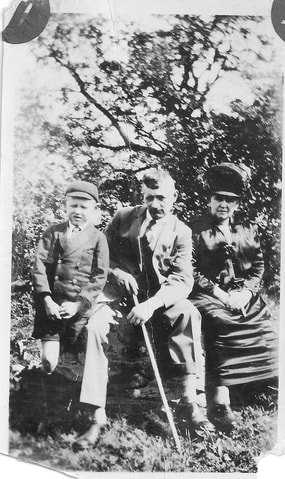 Eric, Percy and Ann Jane on holiday in Threshfield, 1928. © Dave Joy 2017
Eric, Percy and Ann Jane on holiday in Threshfield, 1928. © Dave Joy 2017
1928
In the summer of 1928 the whole of Island Road School moved to Danefield Road, which had been built three years earlier. The problem was that most of those who attended Island Road School, lived on the ‘Springwood’ estate - like my cousin Ivy did - and it was easy to get to for them, but not for me. There were no school dinners and I used to get wet through going home for dinner. I only went there for six months (until the beginning of ‘29).
That year we went to Threshfield for a holiday and while we were there my father took ill. He was so ill that my mother feared that he had pneumonia. I was asleep and didn’t find out until the morning, but he had started in the middle of the night and the doctor had been sent for. The doctor kept him in bed for three days while my mother dosed him with whiskey - that brought his temperature down. It wasn’t much of a holiday for him and he spent most of the rest of his holiday just walking around Threshfield, getting back on his feet again. Also, his mother (my Nana), Ann Jane (nee Percival) came with us on that holiday and I have a number of photographs of the three of us.
Also in 1928 there was a wedding. On Easter Monday my Aunty Flora was married to George Price. He was a grocer and she met him while he was serving his time with ‘Brookes’, the grocers in Garston; he served his time along with members of the Tushingham family (Rita Tushingham became a film star). It was a skilled profession in those days because as well as groceries they also did ‘provisions’ which meant doing things like boning bacon and patting butter and packing sugar. George Price’s father set him up in a shop in Edge Lane on the corner of Jubilee Drive.
In the summer of 1928 the whole of Island Road School moved to Danefield Road, which had been built three years earlier. The problem was that most of those who attended Island Road School, lived on the ‘Springwood’ estate - like my cousin Ivy did - and it was easy to get to for them, but not for me. There were no school dinners and I used to get wet through going home for dinner. I only went there for six months (until the beginning of ‘29).
That year we went to Threshfield for a holiday and while we were there my father took ill. He was so ill that my mother feared that he had pneumonia. I was asleep and didn’t find out until the morning, but he had started in the middle of the night and the doctor had been sent for. The doctor kept him in bed for three days while my mother dosed him with whiskey - that brought his temperature down. It wasn’t much of a holiday for him and he spent most of the rest of his holiday just walking around Threshfield, getting back on his feet again. Also, his mother (my Nana), Ann Jane (nee Percival) came with us on that holiday and I have a number of photographs of the three of us.
Also in 1928 there was a wedding. On Easter Monday my Aunty Flora was married to George Price. He was a grocer and she met him while he was serving his time with ‘Brookes’, the grocers in Garston; he served his time along with members of the Tushingham family (Rita Tushingham became a film star). It was a skilled profession in those days because as well as groceries they also did ‘provisions’ which meant doing things like boning bacon and patting butter and packing sugar. George Price’s father set him up in a shop in Edge Lane on the corner of Jubilee Drive.
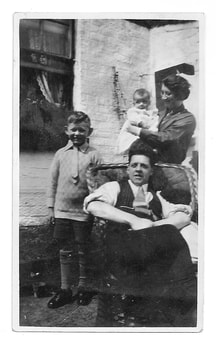 Young Eric with Flora and George Price and baby Doug c.1929. © Dave Joy 2017
Young Eric with Flora and George Price and baby Doug c.1929. © Dave Joy 2017
1929
In 1929 I started at Victoria School; it was named after Queen Victoria who had her Jubilee in 1897, when the school was first opened. The head teacher was a customer of ours and my father spoke to him about me not liking school; he said ‘send him to us, he’ll be alright with us’. There was the ‘Infants’, and ‘first’ and ‘second’ class as they called them; then there was ‘Standard’ 1, 2, 3, 4, 5, 6 and 7. The Infants and Standards 1 and 2 were on the ground floor; everyone else was on the first floor. I started school in Standard 3 and we shared a big room with Standard 4. Standard 5 was by itself, to one side. Standard 6 and Standard 7 also had separate classes. But for ‘assembly’ two screens were moved back and Standard 3, 4 and 5 all sat together and Standard 6 and 7 sat together - everyone sharing desks.
Also, in 1929 there was a family birth. My Aunty Flora gave birth to a son, George Douglas Price (Doug), my cousin. He was nine years younger than me but we became very good friends – and remained that way, always.
In 1929 I started at Victoria School; it was named after Queen Victoria who had her Jubilee in 1897, when the school was first opened. The head teacher was a customer of ours and my father spoke to him about me not liking school; he said ‘send him to us, he’ll be alright with us’. There was the ‘Infants’, and ‘first’ and ‘second’ class as they called them; then there was ‘Standard’ 1, 2, 3, 4, 5, 6 and 7. The Infants and Standards 1 and 2 were on the ground floor; everyone else was on the first floor. I started school in Standard 3 and we shared a big room with Standard 4. Standard 5 was by itself, to one side. Standard 6 and Standard 7 also had separate classes. But for ‘assembly’ two screens were moved back and Standard 3, 4 and 5 all sat together and Standard 6 and 7 sat together - everyone sharing desks.
Also, in 1929 there was a family birth. My Aunty Flora gave birth to a son, George Douglas Price (Doug), my cousin. He was nine years younger than me but we became very good friends – and remained that way, always.
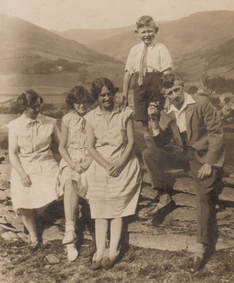 Penmachno, 1929. Ellen, Ivy, Annie, Eric and Percy. © Dave Joy 2017
Penmachno, 1929. Ellen, Ivy, Annie, Eric and Percy. © Dave Joy 2017
That year we had a different holiday. My Aunty Annie and Uncle Joe had bought a small cottage in North Wales; at a place called Penmachno, four miles from Betws-y-Coed. We had a 12-day holiday there, with them: my father and mother and myself, staying with Aunty Annie, Uncle Joe and my cousin Ivy. Uncle Joe used to go there at weekends. Every other week he would work nights and then go to the cottage on Saturday morning. He worked at Garston Docks, which were owned by the railway company and so he was able to travel by train for one quarter of the fare and he was given three free passes per year. He also used to let it out as a holiday cottage. It was half way up a mountain and was rather primitive with an earth closet and no running water, just a stream; we used to boil the water.
Back home, in the theatres, ‘talkies’ had been advertised as coming to town on Easter Monday, 1929 – and they actually did, except they were all upstaged by the Lyceum Theatre, which got them a fortnight earlier. However, the sound in the Lyceum wasn’t as good as in the Garston Empire where they had Western Electric Sound, which was very clear. The first film we saw as a ‘talkie’ was Madam X, starring Ruth Chatterton and Lewis Stone. It was about a woman who had been deserted by her husband and left with a child. Years later she had become involved with someone else and had killed him. It turned out that the lawyer who was going to defend her was her son. The sound for the ‘talkies’ was very good, though I can remember going to the cinema and seeing Ben-Hur as a silent movie, starring Ramon Navarro. The talkies came gradually; we started with Laurel and Hardy as silent movies and then we began to get them as talkies.
1930
In 1930 Bronco Bill’s Circus came to town and pitched their big top at what was called Garston Royal Football Field, on the corner of Speke Road and what is now Horrocks Avenue (where Blessed John Almond school has now been built). Bronco Bill styled himself on Buffalo Bill - he had 20-30 horses and also elephants; that was the first time I’d seen an elephant in the flesh. We watched them being watered during the day; the water tanks went down in front of our eyes as the elephants took on water – that was quite something! My Papa [Grandfather] took me to see 'Bronco Bill', just as he had taken my father to see 'Buffalo Bill' at Newsham Park back in 1891.
In 1930 Bronco Bill’s Circus came to town and pitched their big top at what was called Garston Royal Football Field, on the corner of Speke Road and what is now Horrocks Avenue (where Blessed John Almond school has now been built). Bronco Bill styled himself on Buffalo Bill - he had 20-30 horses and also elephants; that was the first time I’d seen an elephant in the flesh. We watched them being watered during the day; the water tanks went down in front of our eyes as the elephants took on water – that was quite something! My Papa [Grandfather] took me to see 'Bronco Bill', just as he had taken my father to see 'Buffalo Bill' at Newsham Park back in 1891.
We used to have a shed on The Avenue - which ran from Garston Cenotaph (unveiled in 1926), through fields, over the willow beds and stream and came out in Speke Road. The shed was a loose box where we calved cows and also a boiler house where we boiled swill for the pigs. We had nine breeding sows and one boar. The local chip shop would give us their peelings and kids would bring their family leftovers in exchange for a few sweets. It was all boiled in a barrel and fed to the pigs. We would sell the young ‘suckers’ at 10 weeks old, to the sewerage farms at Fazakerley, which were run by the city council. Those pigs were fed on the swill from the hospitals. We would get two litters a year and we kept pigs up until 1938 when we were served notice to quit the land. I had my first pig when I was 16 years old.
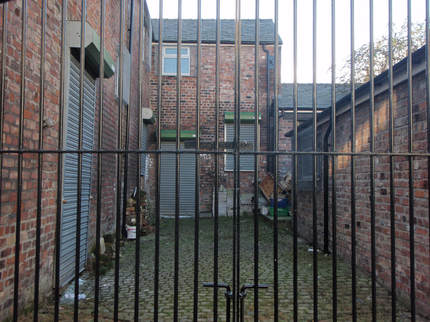 Former shippon, yard and stables, Duke Street, Garston. © Dave Joy 2017
Former shippon, yard and stables, Duke Street, Garston. © Dave Joy 2017
We also had a shippon in Duke Street where we had 24 milking cows and two horses: Sam and Bonnie. Sam was a 13.2 pony who was first purchased in 1923 at the age of 27 and we had him until 1942, when his kidneys packed in and he couldn’t get up so we had to have him put down in his stall. Sam used to bite the buttons off your waistcoat when you were grooming him if you weren’t careful – he was quite a character! We got Bonnie in 1926 and we had her for 15 years until 1941 when she died of pneumonia. I think it was my Uncle Bill who gave them their names. I also had a goat called Nancy. Mr Mullet, the saddler in Garston, gave her to me. He kept two goats (at Mersey View) because his daughter used to have sleeping sickness; I think that was because goats’ milk is naturally tuberculoses-tested, as goats do not get TB. She was just weaned when I got her. She used to come in the house, stand on her hind legs with her feet on the sideboard and eat the flowers. My mother did not think much of that at all! One of customers made a cart for her and I used to drive her in the cart; that was before I graduated to driving horses.
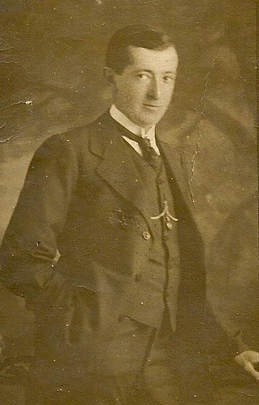 Eric's uncle, George Joy © Dave Joy 2017
Eric's uncle, George Joy © Dave Joy 2017
1931
1931 was the beginning of the Great Depression. You often got people singing in the street for money. I once gave a chap a penny and as he turned away he fell flat on his face. Mr Shuker came out from number 5 and dragged him onto the pavement. They said he had collapsed because he hadn’t eaten for a couple of days. Somebody gave him a cup of tea and a sandwich. Another chap came to our house one day asking for work. He had walked and hitchhiked from Hull in search of work and was now going to go back again as he hadn’t been able to find any in Liverpool. We gave him a cup of tea and a sandwich to help him on his way. On another occasion I was out in the float with my dad and Sam, when we drew level with a chap in King Street and he fell flat on his face. Dad bought him a cup of tea and a pastie from the cake shop. People were exhausted and starving.
On a happier note, that same year my Aunty Kath was married to Hughie Roberts, who had been a friend and swimming partner with my Uncle Bill since they were boys. She had known him for most of her life; his father was the Pier Master and they lived in Seddon Road. Hughie was an apprentice and served his time as a mate and when he got his captain’s ticket as a deep sea-diver, that’s when he asked Kath to marry him. They married in 1931 and went to live at 54 Lovelace Road.
1932
In the April of 1932, Aunty Kath gave birth to their first child – Robert Anthony Roberts (named after his two grandfathers). But, Aunty Kath’s health was not good and she had a number of blackouts. As her husband was away at sea, spending 10 months working up the River Amazon, we moved out of 39 Wellington Street and moved in with Aunty Kath at Lovelace Road. We stayed there for two years, until June 1934.
Uncle George, who married in 1926 and was living over Percy Chapman’s shop in St Mary’s Road, moved in to 39 Wellington Street. George married Mary Westwood, a lady from Northern Ireland. She was a widow. Her husband, who had been stationed over in Ireland with the Inniskilling Fusiliers, was killed during the Great War. She had a daughter named Lillian who was only an infant when her father was killed. So, Mary came over from Northern Ireland to live with her husband’s family in Clifton Street. At the time that she married George, Mr Westwood Senior (Lilly’s grandfather) still lived in Clifton Street.
It was at that time that I started taking piano lessons from Mrs Evans, who before her marriage was Ena Inch; her sister was Winney Inch, the hairdresser. I took lessons for two years and then gave it up as a bad job!
Other things that happened in 1932 included the widening of the Woolton Road railway bridge over the Cheshire Lines Railway - they built it fan shaped at one end so that they could operate a circular tram route through Garston. Also, there was another circus visiting Liverpool: the Bertram Mills Circus came to ‘The Mystery’ ground in Wavertree. He had elephants, lions, tigers, liberty horses and performing mules (a chap named John Grindle trained the mules). The Baker Boys did a vaulting act – in fact, one of the Baker Boys was still going when they came back to Liverpool in 1962 and I took David to see them.
1931 was the beginning of the Great Depression. You often got people singing in the street for money. I once gave a chap a penny and as he turned away he fell flat on his face. Mr Shuker came out from number 5 and dragged him onto the pavement. They said he had collapsed because he hadn’t eaten for a couple of days. Somebody gave him a cup of tea and a sandwich. Another chap came to our house one day asking for work. He had walked and hitchhiked from Hull in search of work and was now going to go back again as he hadn’t been able to find any in Liverpool. We gave him a cup of tea and a sandwich to help him on his way. On another occasion I was out in the float with my dad and Sam, when we drew level with a chap in King Street and he fell flat on his face. Dad bought him a cup of tea and a pastie from the cake shop. People were exhausted and starving.
On a happier note, that same year my Aunty Kath was married to Hughie Roberts, who had been a friend and swimming partner with my Uncle Bill since they were boys. She had known him for most of her life; his father was the Pier Master and they lived in Seddon Road. Hughie was an apprentice and served his time as a mate and when he got his captain’s ticket as a deep sea-diver, that’s when he asked Kath to marry him. They married in 1931 and went to live at 54 Lovelace Road.
1932
In the April of 1932, Aunty Kath gave birth to their first child – Robert Anthony Roberts (named after his two grandfathers). But, Aunty Kath’s health was not good and she had a number of blackouts. As her husband was away at sea, spending 10 months working up the River Amazon, we moved out of 39 Wellington Street and moved in with Aunty Kath at Lovelace Road. We stayed there for two years, until June 1934.
Uncle George, who married in 1926 and was living over Percy Chapman’s shop in St Mary’s Road, moved in to 39 Wellington Street. George married Mary Westwood, a lady from Northern Ireland. She was a widow. Her husband, who had been stationed over in Ireland with the Inniskilling Fusiliers, was killed during the Great War. She had a daughter named Lillian who was only an infant when her father was killed. So, Mary came over from Northern Ireland to live with her husband’s family in Clifton Street. At the time that she married George, Mr Westwood Senior (Lilly’s grandfather) still lived in Clifton Street.
It was at that time that I started taking piano lessons from Mrs Evans, who before her marriage was Ena Inch; her sister was Winney Inch, the hairdresser. I took lessons for two years and then gave it up as a bad job!
Other things that happened in 1932 included the widening of the Woolton Road railway bridge over the Cheshire Lines Railway - they built it fan shaped at one end so that they could operate a circular tram route through Garston. Also, there was another circus visiting Liverpool: the Bertram Mills Circus came to ‘The Mystery’ ground in Wavertree. He had elephants, lions, tigers, liberty horses and performing mules (a chap named John Grindle trained the mules). The Baker Boys did a vaulting act – in fact, one of the Baker Boys was still going when they came back to Liverpool in 1962 and I took David to see them.
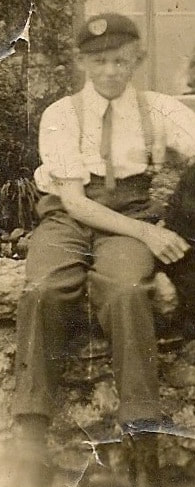 Long Trousers! 1933.© Dave Joy 2017
Long Trousers! 1933.© Dave Joy 2017
1933
At the beginning of 1933 I got my first pair of long trousers, for Sundays only – my Sunday Suit. I then wore long trousers when I went back to school at the end of ’33, together with a black blazer, a black school cap with a badge showing a red ‘V’ and grey flannels.
1934
In February 1934, I went to school one day and I couldn’t get my eyes open. I went home to Lovelace Road and they thought I had tonsillitis, but I just got worse. I had been off for a week with a temperature of 104 and they were bathing me with cold water trying to get my temperature down. In the end our doctor brought out a specialist, named Murray Blythe. He looked at me and he said it was German measles, which was going around at the time. Later, I found out that the doctor had expressed his ‘concern about young Eric, as he was their only child’ - because it was something you could die from. Anyway, the measles came out and eventually I got better.
The only good thing to come out of German measles is that I didn’t go back to school (except for one day when they asked my dad to send me in because they were expecting an inspector!) In class I could hear horses going past outside: the coalman or Matt Whitfield trotting past with his van – I could tell which tradesman it was by the sound of the horses’ hooves. I really did not like being in school. I wanted to be outdoors!
At the beginning of 1933 I got my first pair of long trousers, for Sundays only – my Sunday Suit. I then wore long trousers when I went back to school at the end of ’33, together with a black blazer, a black school cap with a badge showing a red ‘V’ and grey flannels.
1934
In February 1934, I went to school one day and I couldn’t get my eyes open. I went home to Lovelace Road and they thought I had tonsillitis, but I just got worse. I had been off for a week with a temperature of 104 and they were bathing me with cold water trying to get my temperature down. In the end our doctor brought out a specialist, named Murray Blythe. He looked at me and he said it was German measles, which was going around at the time. Later, I found out that the doctor had expressed his ‘concern about young Eric, as he was their only child’ - because it was something you could die from. Anyway, the measles came out and eventually I got better.
The only good thing to come out of German measles is that I didn’t go back to school (except for one day when they asked my dad to send me in because they were expecting an inspector!) In class I could hear horses going past outside: the coalman or Matt Whitfield trotting past with his van – I could tell which tradesman it was by the sound of the horses’ hooves. I really did not like being in school. I wanted to be outdoors!
Upon leaving school in 1934, at the age of 15, Dad went back to doing what he loved most – working with his family and their animals at Wellington Dairy.
The second item is a poem written by E. Thompson, the Headmaster of the Wesleyan Island Road School, in 1927. What seems to have prompted Mr Thompson to express himself in verse in this way, was his surprise and delight at seven-year-old Eric Joy knowing that G. K. Chesterton had written a biography of Robert Louis Stevenson! A curious but quaint piece of family history.
He was a boy, a little boy, with eyes as blue as heaven,
His fitting name was Eric Joy, his age was only seven.
I stood in front of Std1 and heard them all recite,
One said a verse of Stevenson, all wonder and delight.
"You've spoken very clearly, well, I'd dearly love to see,
If any clever child can tell who this great man can be."
Then up and rose this little boy with eyes as blue as heaven,
His fitting name was Eric Joy, whose age was only seven.
"There lived in London, gold and grey, a man named Chesterton,
And he has written, so they say, memoirs of Stevenson."
MEMORIES OF GARSTON FARM DAYS
(Liverpool Star – Monday 7th March 1991)
Eric Joy of Garston can remember getting up to milk the cows at quarter-to-five on cold winter mornings when he was a young lad. Not that the bright lights lured a farm boy away from a rural area to the big city – Eric, now 71, was one of the famous Cowkeepers of Garston, in the days when dairy farms were scattered about the area.
Eric and his horse and cart were a familiar sight delivering milk Under The Bridge until the 1960s. Said Eric: “Two of us used to deliver and we never had to touch the horse, he knew exactly where to go and when to stop. The chap who eventually took over the delivery had a van and needed three men on the round – two to deliver and one to drive the van! They didn’t get around any quicker.”
Like many others, Eric’s family came from Yorkshire to farm in Garston. “Others came from Westmorland and Cumberland, as times were hard in the farming areas. It was 1863 when my grandfather’s family came from Yorkshire and opened a dairy in Railway Street. They farmed what is now Stalbridge Dock and later lived at Dale House,” he said.
Eric recalls that his grandfather had a shippon in Island Road up until the three fields, which he farmed, were turned into Garston Park in 1901 and his Uncle Bill’s butcher’s shop, W C Joy, was very well known.
Eric’s family later farmed what is now the Horrocks Avenue estate. He remembers the stream, which ran parallel with Stamfordham Drive, under Allerton Station, down to the bottom of St Mary’s Road, Church Road and Dale Street before emptying into the Stalbridge Dock.
“When the by-pass was built the culvert was opened up and people were able to go down and look at the stream,” he recalls.
He remembers when the Windfield Road estate was Marsh’s farm. “George Marsh had three farms on the edge of Garston on the site of what is now Liverpool Airport.”
“There are many people living in the Garston area far older than me who will remember much more than I can, but I’ve always asked lots of questions as I’m very interested in local history.”
Youngsters used to start work at an early age on the Garston farms. “I remember Bill Ashcroft who used to have Dutch Farm telling me that when he was eight his father asked him to take the horse and cart to Cronton one morning to fetch some coal. He said he didn’t know the way, but his father told him to make sure the horse turned right at a certain point and he’d get him there without any problem. The horse did, and Bill got back with the coal in time to have his breakfast and get to school,” chuckled Eric.
He remembers visiting the smithy that was in Chapel Road up until 1941 and getting his horses shod at the farriers in Mossley Hill Road and Woolton Village.
Although after finishing on the milk round Eric went to work for 18 years with Irish Sea Ferries at Garston Docks, he retained his love of horses and regularly used to show them at local events, including Liverpool Show. He also stewards the heavy horses at the Woolton Show and the Lancashire County Show. He still visits livestock fairs a couple of times a year, meeting up with old friends, and as an interest buys and repairs old harnesses, occasionally making exercise carts for horses.
“When I was in the army I met up with two lads from farms, and we still keep in touch to this day. It’s funny how in a situation like that you tend to be pals with people who share your interests.”
